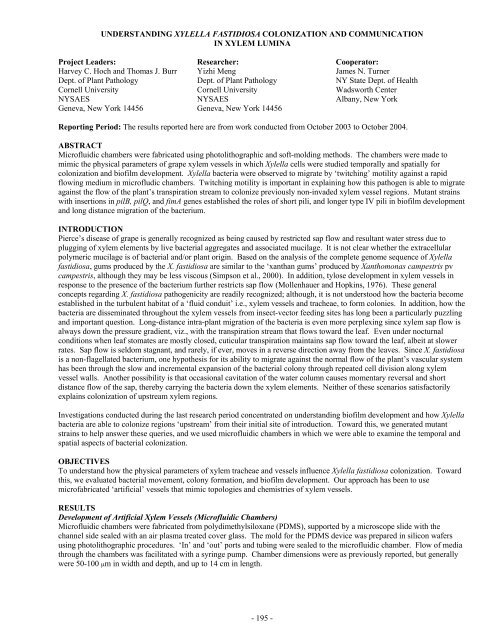Impact Of Host Plant Xylem Fluid On Xylella Fastidiosa Multiplication ...
Impact Of Host Plant Xylem Fluid On Xylella Fastidiosa Multiplication ...
Impact Of Host Plant Xylem Fluid On Xylella Fastidiosa Multiplication ...
Create successful ePaper yourself
Turn your PDF publications into a flip-book with our unique Google optimized e-Paper software.
UNDERSTANDING XYLELLA FASTIDIOSA COLONIZATION AND COMMUNICATION<br />
IN XYLEM LUMINA<br />
Project Leaders:<br />
Harvey C. Hoch and Thomas J. Burr<br />
Dept. of <strong>Plant</strong> Pathology<br />
Cornell University<br />
NYSAES<br />
Geneva, New York 14456<br />
Researcher:<br />
Yizhi Meng<br />
Dept. of <strong>Plant</strong> Pathology<br />
Cornell University<br />
NYSAES<br />
Geneva, New York 14456<br />
Cooperator:<br />
James N. Turner<br />
NY State Dept. of Health<br />
Wadsworth Center<br />
Albany, New York<br />
Reporting Period: The results reported here are from work conducted from October 2003 to October 2004.<br />
ABSTRACT<br />
Microfluidic chambers were fabricated using photolithographic and soft-molding methods. The chambers were made to<br />
mimic the physical parameters of grape xylem vessels in which <strong>Xylella</strong> cells were studied temporally and spatially for<br />
colonization and biofilm development. <strong>Xylella</strong> bacteria were observed to migrate by ‘twitching’ motility against a rapid<br />
flowing medium in microfludic chambers. Twitching motility is important in explaining how this pathogen is able to migrate<br />
against the flow of the plant’s transpiration stream to colonize previously non-invaded xylem vessel regions. Mutant strains<br />
with insertions in pilB, pilQ, and fimA genes established the roles of short pili, and longer type IV pili in biofilm development<br />
and long distance migration of the bacterium.<br />
INTRODUCTION<br />
Pierce’s disease of grape is generally recognized as being caused by restricted sap flow and resultant water stress due to<br />
plugging of xylem elements by live bacterial aggregates and associated mucilage. It is not clear whether the extracellular<br />
polymeric mucilage is of bacterial and/or plant origin. Based on the analysis of the complete genome sequence of <strong>Xylella</strong><br />
fastidiosa, gums produced by the X. fastidiosa are similar to the ‘xanthan gums’ produced by Xanthomonas campestris pv<br />
campestris, although they may be less viscous (Simpson et al., 2000). In addition, tylose development in xylem vessels in<br />
response to the presence of the bacterium further restricts sap flow (Mollenhauer and Hopkins, 1976). These general<br />
concepts regarding X. fastidiosa pathogenicity are readily recognized; although, it is not understood how the bacteria become<br />
established in the turbulent habitat of a ‘fluid conduit’ i.e., xylem vessels and tracheae, to form colonies. In addition, how the<br />
bacteria are disseminated throughout the xylem vessels from insect-vector feeding sites has long been a particularly puzzling<br />
and important question. Long-distance intra-plant migration of the bacteria is even more perplexing since xylem sap flow is<br />
always down the pressure gradient, viz., with the transpiration stream that flows toward the leaf. Even under nocturnal<br />
conditions when leaf stomates are mostly closed, cuticular transpiration maintains sap flow toward the leaf, albeit at slower<br />
rates. Sap flow is seldom stagnant, and rarely, if ever, moves in a reverse direction away from the leaves. Since X. fastidiosa<br />
is a non-flagellated bacterium, one hypothesis for its ability to migrate against the normal flow of the plant’s vascular system<br />
has been through the slow and incremental expansion of the bacterial colony through repeated cell division along xylem<br />
vessel walls. Another possibility is that occasional cavitation of the water column causes momentary reversal and short<br />
distance flow of the sap, thereby carrying the bacteria down the xylem elements. Neither of these scenarios satisfactorily<br />
explains colonization of upstream xylem regions.<br />
Investigations conducted during the last research period concentrated on understanding biofilm development and how <strong>Xylella</strong><br />
bacteria are able to colonize regions ‘upstream’ from their initial site of introduction. Toward this, we generated mutant<br />
strains to help answer these queries, and we used microfluidic chambers in which we were able to examine the temporal and<br />
spatial aspects of bacterial colonization.<br />
OBJECTIVES<br />
To understand how the physical parameters of xylem tracheae and vessels influence <strong>Xylella</strong> fastidiosa colonization. Toward<br />
this, we evaluated bacterial movement, colony formation, and biofilm development. Our approach has been to use<br />
microfabricated ‘artificial’ vessels that mimic topologies and chemistries of xylem vessels.<br />
RESULTS<br />
Development of Artificial <strong>Xylem</strong> Vessels (Microfluidic Chambers)<br />
Microfluidic chambers were fabricated from polydimethylsiloxane (PDMS), supported by a microscope slide with the<br />
channel side sealed with an air plasma treated cover glass. The mold for the PDMS device was prepared in silicon wafers<br />
using photolithographic procedures. ‘In’ and ‘out’ ports and tubing were sealed to the microfluidic chamber. Flow of media<br />
through the chambers was facilitated with a syringe pump. Chamber dimensions were as previously reported, but generally<br />
were 50-100 µm in width and depth, and up to 14 cm in length.<br />
- 195 -











